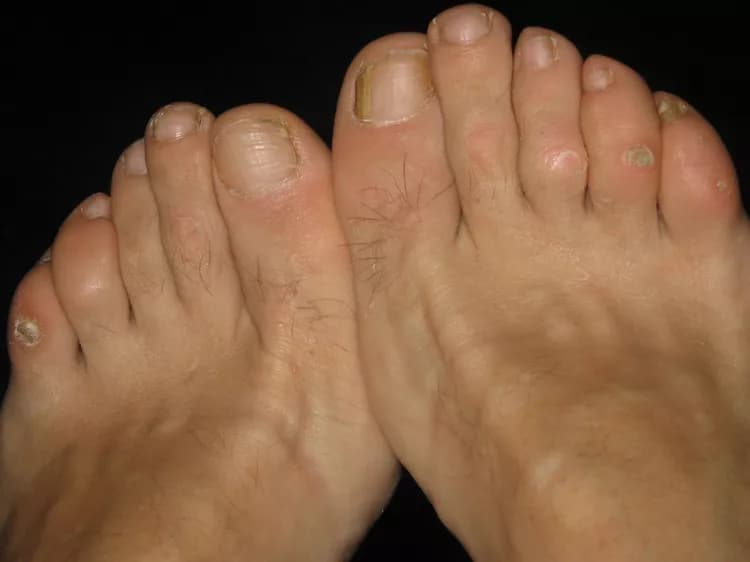What are the other Names for this Condition? (Also known as/Synonyms)
- Calluses and Corns
What are Corns and Calluses? (Definition/Background Information)
- Calluses are areas of thickened layers of skin that develop on the bottom of the foot, due to abnormal pressure or constant rubbing
- Corns are thickened layers of compact dead skin that develop on the foot or toe
- Corns and Calluses normally develop on the foot and toes, or hands and fingers. Usually, they are a cosmetic and functional problem
- Mostly, non-surgical methods are usually used to treat the condition; in rare cases, a surgery may be required
Who gets Corns and Calluses? (Age and Sex Distribution)
- Calluses may occur equally in both men and women of all races, and ethnic groups. However, Corns occur at a higher rate in women
- The incidence increases with age and it is uncommon in children
- Elderly individuals are generally more susceptible to the growth of Corns and Calluses, due to a wearing down of the fatty tissues present on the soles of the feet
What are the Risk Factors for Corns and Calluses? (Predisposing Factors)
Common risk factors associated with Corns and Calluses include:
- Presence of bunions, hammertoes, clubfoot, or mallet toes
- Congenital foot abnormalities
- Advancing age
- Farmers, rowers, or musical instrument players, who use hand tools or instruments, for long periods (without wearing suitable protective gloves/gear) exposing the skin to excessive friction
It is important to note that having a risk factor does not mean that one will get the condition. A risk factor increases ones chances of getting a condition compared to an individual without the risk factors. Some risk factors are more important than others.
Also, not having a risk factor does not mean that an individual will not get the condition. It is always important to discuss the effect of risk factors with your healthcare provider.
What are the Causes of Corns and Calluses? (Etiology)
A few causes associated with Corns and Calluses include:
- Wearing ill-fitting shoes
- Not wearing gloves while performing certain physical tasks that cause persistent abnormal pressure on the soles of the hands, resulting in the formation of Corns and Calluses
- Any situation that increases the frictional pressure on skin in the affected region (hands or feet)
What are the Signs and Symptoms of Corns and Calluses?
The terms ‘Corns’ and ‘Calluses’ are frequently confused and used interchangeably. However, they are different. The signs and symptoms of these include:
- Corns: Corns are usually smaller than Calluses and may cause inflammation of the surrounding skin tissue. This may result in persistent pain when pressed, or when any force is applied on them
- Calluses: Calluses usually develop on the bottom of the feet and are usually larger in shape and size than Corns. They are rarely painful. Calluses are caused by an abnormal pressure on the skin, or due to constant friction or rubbing against the skin
How is Corns and Calluses Diagnosed?
Diagnostic methods that a physician may use to help diagnose Corns and Calluses include:
- Physical examination: A thorough physical examination of the hands or feet is usually adequate, to diagnose Corns or Calluses. In addition to this, a complete medical history may aid in arriving at a definitive diagnosis
- X-ray of the hand or foot: A physician may order an X-ray, to see if any underlying bony abnormalities are causing this condition
- Biopsy of the hand or foot: Occasionally, a biopsy may be necessary to rule out the possibility of a viral wart, or an underlying cyst. The biopsy specimen is examined under the microscope by a pathologist
Many clinical conditions may have similar signs and symptoms. Your healthcare provider may perform additional tests to rule out other clinical conditions to arrive at a definitive diagnosis.
What are the possible Complications of Corns and Calluses?
Complications associated with Corns and Calluses are rare. A few complications could include:
- This condition may be problematic in individuals who are diabetic. With poorly controlled diabetes leading to decreased peripheral sensation (diabetic neuropathy) the Corns and Calluses may become infected, and they may ulcerate
- Ulcerated Corns or Calluses may cause infection of the underlying bone, resulting in a serious illness called osteomyelitis. Osteomyelitis is defined as an infection of the bone
- Cosmetic problems
How are Corns and Calluses Treated?
Corns and Calluses may be managed using both nonsurgical and surgical treatment methods.
- The physician may use a scalpel, to trim the excess skin tissue. This is painless, as the tissue is compact insensate keratin
- Salicylic acid patches may be used to flatten the Corns or Calluses, by removing the dead skin
- If Corns or Calluses result in an ulcer, then the treatment of the ulcer using antibiotic ointments may be recommended by a physician, in order to decrease any risk of infection
- Silicon spacers (available without prescription) with a hole to accommodate the corn can be uses to separate toes and decrease pain
- A physician may prescribe a well-padded custom-made shoe insert, to prevent any recurrence of Corns or Calluses
- In rare cases, if Corns and Calluses are caused by abnormal bone defects, such as bunions; then, surgical procedures to correct this abnormality may be used, and to also eliminate any chances of their recurrence
How can Corns and Calluses be Prevented?
Some simple techniques to help prevent Corns and Calluses are:
- Wear protective gloves or suitable hand gear, when using hand tools, playing musical instruments, etc.
- Wear an appropriate shoe size
- Wear a well-padded custom-made shoe insert, to prevent friction on the bottom of the foot
What is the Prognosis of Corns and Calluses? (Outcomes/Resolutions)
- Generally, Corns and Calluses are not serious conditions. They can be suitably managed with appropriate treatment procedures
- Even though Corns and Calluses may recur if they are removed, recurrences are less likely for individuals who use proper foot padding and shoe inserts
Additional and Relevant Useful Information for Corns and Calluses:
The following article links will help you understand bunion removal procedure:
https://www.dovemed.com/common-procedures/procedures-surgical/bunion-removal/
Related Articles
Test Your Knowledge
Asked by users
Related Centers
Related Specialties
Related Physicians
Related Procedures
Related Resources
Join DoveHubs
and connect with fellow professionals



0 Comments
Please log in to post a comment.